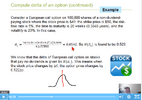Hello,
in the video "Instructional Video: Option Sensitivity Measures: The “Greeks”", there is this slide:

I am confused as to what normal distribution it refers to? Considering that N(d1) comes out to be 0.522, I understand that in the conditional density function, 52.2% of the values are "to the left" of the value. How should I view this in a normal distribution? What are the values on this distributions "x" axis?
in the video "Instructional Video: Option Sensitivity Measures: The “Greeks”", there is this slide:

I am confused as to what normal distribution it refers to? Considering that N(d1) comes out to be 0.522, I understand that in the conditional density function, 52.2% of the values are "to the left" of the value. How should I view this in a normal distribution? What are the values on this distributions "x" axis?
